#american prisoners
Text

In 1865, enslaved people in Texas were notified by Union Civil War soldiers about the abolition of slavery. This was 2.5 years after the final Emancipation Proclamation which freed all enslaved Black Americans.
But Slavery Continued… In 1866, a year after the amendment was ratified, Alabama, Texas, Louisiana, Arkansas, Georgia, Mississippi, Florida, Tennessee, and South Carolina began to lease out convicts for labor.
This made the business of arresting black people very lucrative, thus hundreds of white men were hired by these states as police officers.
Their primary responsibility being to search out and arrest black peoples who were in violation of ‘Black Codes’
Basically, black codes were a series of laws criminalizing legal activity for black people. Through the enforcement of these laws, they could be imprisoned.
Once arrested, these men, women & children would be leased to plantations or they would be leased to work at coal mines, or railroad companies. The owners of these businesses would pay the state for every prisoner who worked for them; prison labor.
It’s believed that after the passing of the 13th Amendment, more than 800,000 Black people were part of that system of re-enslavement through the prison system.
The 13th Amendment declared that "Neither slavery nor involuntary servitude, except as a punishment for crime whereof the party shall have been duly convicted, shall exist within the United States, or any place subject to their jurisdiction."
Lawmakers used this phrase to make petty offenses crimes. When Blacks were found guilty of committing these crimes, they were imprisoned and then leased out to the same businesses that lost slaves after the passing of the 13th Amendment.
The majority of White Southern farmers and business owners hated the 13th Amendment because it took away slave labor. As a way to appease them, the federal government turned a blind eye when southern states used this clause in the 13th Amendment to establish the Black Codes.
#slavery#emancipation proclamation#black americans#convict leasing#black codes#13th amendment#involuntary servitude#prison labor#re-enslavement#southern states#racial discrimination
802 notes
·
View notes
Text
How to shatter the class solidarity of the ruling class
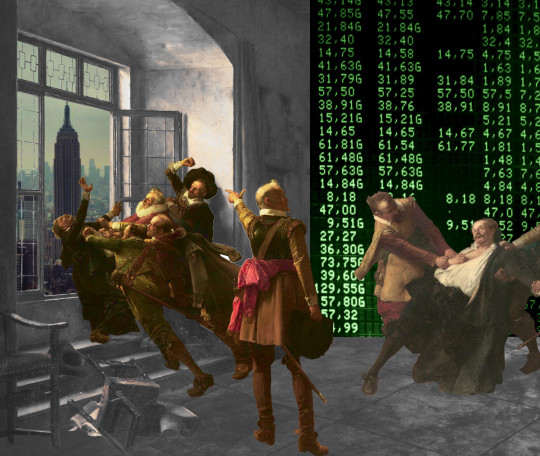
I'm touring my new, nationally bestselling novel The Bezzle! Catch me WEDNESDAY (Apr 11) at UCLA, then Chicago (Apr 17), Torino (Apr 21) Marin County (Apr 27), Winnipeg (May 2), Calgary (May 3), Vancouver (May 4), and beyond!

Audre Lorde counsels us that "The Master's Tools Will Never Dismantle the Master's House," while MLK said "the law cannot make a man love me, but it can restrain him from lynching me." Somewhere between replacing the system and using the system lies a pragmatic – if easily derailed – course.
Lorde is telling us that a rotten system can't be redeemed by using its own chosen reform mechanisms. King's telling us that unless we live, we can't fight – so anything within the system that makes it easier for your comrades to fight on can hasten the end of the system.
Take the problems of journalism. One old model of journalism funding involved wealthy newspaper families profiting handsomely by selling local appliance store owners the right to reach the townspeople who wanted to read sports-scores. These families expressed their patrician love of their town by peeling off some of those profits to pay reporters to sit through municipal council meetings or even travel overseas and get shot at.
In retrospect, this wasn't ever going to be a stable arrangement. It relied on both the inconstant generosity of newspaper barons and the absence of a superior way to show washing-machine ads to people who might want to buy washing machines. Neither of these were good long-term bets. Not only were newspaper barons easily distracted from their sense of patrician duty (especially when their own power was called into question), but there were lots of better ways to connect buyers and sellers lurking in potentia.
All of this was grossly exacerbated by tech monopolies. Tech barons aren't smarter or more evil than newspaper barons, but they have better tools, and so now they take 51 cents out of every ad dollar and 30 cents out of ever subscriber dollar and they refuse to deliver the news to users who explicitly requested it, unless the news company pays them a bribe to "boost" their posts:
https://www.eff.org/deeplinks/2023/04/saving-news-big-tech
The news is important, and people sign up to make, digest, and discuss the news for many non-economic reasons, which means that the news continues to struggle along, despite all the economic impediments and the vulture capitalists and tech monopolists who fight one another for which one will get to take the biggest bite out of the press. We've got outstanding nonprofit news outlets like Propublica, journalist-owned outlets like 404 Media, and crowdfunded reporters like Molly White (and winner-take-all outlets like the New York Times).
But as Hamilton Nolan points out, "that pot of money…is only large enough to produce a small fraction of the journalism that was being produced in past generations":
https://www.hamiltonnolan.com/p/what-will-replace-advertising-revenue
For Nolan, "public funding of journalism is the only way to fix this…If we accept that journalism is not just a business or a form of entertainment but a public good, then funding it with public money makes perfect sense":
https://www.hamiltonnolan.com/p/public-funding-of-journalism-is-the
Having grown up in Canada – under the CBC – and then lived for a quarter of my life in the UK – under the BBC – I am very enthusiastic about Nolan's solution. There are obvious problems with publicly funded journalism, like the politicization of news coverage:
https://www.theguardian.com/media/2023/jan/24/panel-approving-richard-sharp-as-bbc-chair-included-tory-party-donor
And the transformation of the funding into a cheap political football:
https://www.cbc.ca/news/politics/poilievre-defund-cbc-change-law-1.6810434
But the worst version of those problems is still better than the best version of the private-equity-funded model of news production.
But Nolan notes the emergence of a new form of hedge fund news, one that is awfully promising, and also terribly fraught: Hunterbrook Media, an investigative news outlet owned by short-sellers who pay journalists to research and publish damning reports on companies they hold a short position on:
https://hntrbrk.com/
For those of you who are blissfully distant from the machinations of the financial markets, "short selling" is a wager that a company's stock price will go down. A gambler who takes a short position on a company's stock can make a lot of money if the company stumbles or fails altogether (but if the company does well, the short can suffer literally unlimited losses).
Shorts have historically paid analysts to dig into companies and uncover the sins hidden on their balance-sheets, but as Matt Levine points out, journalists work for a fraction of the price of analysts and are at least as good at uncovering dirt as MBAs are:
https://www.bloomberg.com/opinion/articles/2024-04-02/a-hedge-fund-that-s-also-a-newspaper
What's more, shorts who discover dirt on a company still need to convince journalists to publicize their findings and trigger the sell-off that makes their short position pay off. Shorts who own a muckraking journalistic operation can skip this step: they are the journalists.
There's a way in which this is sheer genius. Well-funded shorts who don't care about the news per se can still be motivated into funding freely available, high-quality investigative journalism about corporate malfeasance (notoriously, one of the least attractive forms of journalism for advertisers). They can pay journalists top dollar – even bid against each other for the most talented journalists – and supply them with all the tools they need to ply their trade. A short won't ever try the kind of bullshit the owners of Vice pulled, paying themselves millions while their journalists lose access to Lexisnexis or the PACER database:
https://pluralistic.net/2024/02/24/anti-posse/#when-you-absolutely-positively-dont-give-a-solitary-single-fuck
The shorts whose journalists are best equipped stand to make the most money. What's not to like?
Well, the issue here is whether the ruling class's sense of solidarity is stronger than its greed. The wealthy have historically oscillated between real solidarity (think of the ultrawealthy lobbying to support bipartisan votes for tax cuts and bailouts) and "war of all against all" (as when wealthy colonizers dragged their countries into WWI after the supply of countries to steal ran out).
After all, the reason companies engage in the scams that shorts reveal is that they are profitable. "Behind every great fortune is a great crime," and that's just great. You don't win the game when you get into heaven, you win it when you get into the Forbes Rich List.
Take monopolies: investors like the upside of backing an upstart company that gobbles up some staid industry's margins – Amazon vs publishing, say, or Uber vs taxis. But while there's a lot of upside in that move, there's also a lot of risk: most companies that set out to "disrupt" an industry sink, taking their investors' capital down with them.
Contrast that with monopolies: backing a company that merges with its rivals and buys every small company that might someday grow large is a sure thing. Shriven of "wasteful competition," a company can lower quality, raise prices, capture its regulators, screw its workers and suppliers and laugh all the way to Davos. A big enough company can ignore the complaints of those workers, customers and regulators. They're not just too big to fail. They're not just too big to jail. They're too big to care:
https://pluralistic.net/2024/04/04/teach-me-how-to-shruggie/#kagi
Would-be monopolists are stuck in a high-stakes Prisoner's Dilemma. If they cooperate, they can screw over everyone else and get unimaginably rich. But if one party defects, they can raid the monopolist's margins, short its stock, and snitch to its regulators.
It's true that there's a clear incentive for hedge-fund managers to fund investigative journalism into other hedge-fund managers' portfolio companies. But it would be even more profitable for both of those hedgies to join forces and collude to screw the rest of us over. So long as they mistrust each other, we might see some benefit from that adversarial relationship. But the point of the 0.1% is that there aren't very many of them. The Aspen Institute can rent a hall that will hold an appreciable fraction of that crowd. They buy their private jets and bespoke suits and powdered rhino horn from the same exclusive sellers. Their kids go to the same elite schools. They know each other, and they have every opportunity to get drunk together at a charity ball or a society wedding and cook up a plan to join forces.
This is the problem at the core of "mechanism design" grounded in "rational self-interest." If you try to create a system where people do the right thing because they're selfish assholes, you normalize being a selfish asshole. Eventually, the selfish assholes form a cozy little League of Selfish Assholes and turn on the rest of us.
Appeals to morality don't work on unethical people, but appeals to immorality crowds out ethics. Take the ancient split between "free software" (software that is designed to maximize the freedom of the people who use it) and "open source software" (identical to free software, but promoted as a better way to make robust code through transparency and peer review).
Over the years, open source – an appeal to your own selfish need for better code – triumphed over free software, and its appeal to the ethics of a world of "software freedom." But it turns out that while the difference between "open" and "free" was once mere semantics, it's fully possible to decouple the two. Today, we have lots of "open source": you can see the code that Google, Microsoft, Apple and Facebook uses, and even contribute your labor to it for free. But you can't actually decide how the software you write works, because it all takes a loop through Google, Microsoft, Apple or Facebook's servers, and only those trillion-dollar tech monopolists have the software freedom to determine how those servers work:
https://pluralistic.net/2020/05/04/which-side-are-you-on/#tivoization-and-beyond
That's ruling class solidarity. The Big Tech firms have hidden a myriad of sins beneath their bafflegab and balance-sheets. These (as yet) undiscovered scams constitute a "bezzle," which JK Galbraith defined as "the magic interval when a confidence trickster knows he has the money he has appropriated but the victim does not yet understand that he has lost it."
The purpose of Hunterbrook is to discover and destroy bezzles, hastening the moment of realization that the wealth we all feel in a world of seemingly orderly technology is really an illusion. Hunterbrook certainly has its pick of bezzles to choose from, because we are living in a Golden Age of the Bezzle.
Which is why I titled my new novel The Bezzle. It's a tale of high-tech finance scams, starring my two-fisted forensic accountant Marty Hench, and in this volume, Hench is called upon to unwind a predatory prison-tech scam that victimizes the most vulnerable people in America – our army of prisoners – and their families:
https://us.macmillan.com/books/9781250865878/thebezzle
The scheme I fictionalize in The Bezzle is very real. Prison-tech monopolists like Securus and Viapath bribe prison officials to abolish calls, in-person visits, mail and parcels, then they supply prisoners with "free" tablets where they pay hugely inflated rates to receive mail, speak to their families, and access ebooks, distance education and other electronic media:
https://pluralistic.net/2024/04/02/captive-customers/#guillotine-watch
But a group of activists have cornered these high-tech predators, run them to ground and driven them to the brink of extinction, and they've done it using "the master's tools" – with appeals to regulators and the finance sector itself.
Writing for The Appeal, Dana Floberg and Morgan Duckett describe the campaign they waged with Worth Rises to bankrupt the prison-tech sector:
https://theappeal.org/securus-bankruptcy-prison-telecom-industry/
Here's the headline figure: Securus is $1.8 billion in debt, and it has eight months to find a financier or it will go bust. What's more, all the creditors it might reasonably approach have rejected its overtures, and its bonds have been downrated to junk status. It's a dead duck.
Even better is how this happened. Securus's debt problems started with its acquisition, a leveraged buyout by Platinum Equity, who borrowed heavily against the firm and then looted it with bogus "management fees" that meant that the debt continued to grow, despite Securus's $700m in annual revenue from America's prisoners. Platinum was just the last in a long line of PE companies that loaded up Securus with debt and merged it with its competitors, who were also mortgaged to make profits for other private equity funds.
For years, Securus and Platinum were able to service their debt and roll it over when it came due. But after Worth Rises got NYC to pass a law making jail calls free, creditors started to back away from Securus. It's one thing for Securus to charge $18 for a local call from a prison when it's splitting the money with the city jail system. But when that $18 needs to be paid by the city, they're going to demand much lower prices. To make things worse for Securus, prison reformers got similar laws passed in San Francisco and in Connecticut.
Securus tried to outrun its problems by gobbling up one of its major rivals, Icsolutions, but Worth Rises and its coalition convinced regulators at the FCC to block the merger. Securus abandoned the deal:
https://worthrises.org/blogpost/securusmerger
Then, Worth Rises targeted Platinum Equity, going after the pension funds and other investors whose capital Platinum used to keep Securus going. The massive negative press campaign led to eight-figure disinvestments:
https://www.latimes.com/business/story/2019-09-05/la-fi-tom-gores-securus-prison-phone-mass-incarceration
Now, Securus's debt became "distressed," trading at $0.47 on the dollar. A brief, covid-fueled reprieve gave Securus a temporary lifeline, as prisoners' families were barred from in-person visits and had to pay Securus's rates to talk to their incarcerated loved ones. But after lockdown, Securus's troubles picked up right where they left off.
They targeted Platinum's founder, Tom Gores, who papered over his bloody fortune by styling himself as a philanthropist and sports-team owner. After a campaign by Worth Rises and Color of Change, Gores was kicked off the Los Angeles County Museum of Art board. When Gores tried to flip Securus to a SPAC – the same scam Trump pulled with Truth Social – the negative publicity about Securus's unsound morals and financials killed the deal:
https://twitter.com/WorthRises/status/1578034977828384769
Meanwhile, more states and cities are making prisoners' communications free, further worsening Securus's finances:
https://pluralistic.net/2024/02/14/minnesota-nice/#shitty-technology-adoption-curve
Congress passed the Martha Wright-Reed Just and Reasonable Communications Act, giving the FCC the power to regulate the price of federal prisoners' communications. Securus's debt prices tumbled further:
https://www.govtrack.us/congress/bills/117/s1541
Securus's debts were coming due: it owes $1.3b in 2024, and hundreds of millions more in 2025. Platinum has promised a $400m cash infusion, but that didn't sway S&P Global, a bond-rating agency that re-rated Securus's bonds as "CCC" (compare with "AAA"). Moody's concurred. Now, Securus is stuck selling junk-bonds:
https://www.govtrack.us/congress/bills/117/s1541
The company's creditors have given Securus an eight-month runway to find a new lender before they force it into bankruptcy. The company's debt is trading at $0.08 on the dollar.
Securus's major competitor is Viapath (prison tech is a duopoly). Viapath is also debt-burdened and desperate, thanks to a parallel campaign by Worth Rises, and has tried all of Securus's tricks, and failed:
https://pestakeholder.org/news/american-securities-fails-to-sell-prison-telecom-company-viapath/
Viapath's debts are due next year, and if Securus tanks, no one in their right mind will give Viapath a dime. They're the walking dead.
Worth Rise's brilliant guerrilla warfare against prison-tech and its private equity backers are a master class in using the master's tools to dismantle the master's house. The finance sector isn't a friend of justice or working people, but sometimes it can be used tactically against financialization itself. To paraphrase MLK, "finance can't make a corporation love you, but it can stop a corporation from destroying you."
Yes, the ruling class finds solidarity at the most unexpected moments, and yes, it's easy for appeals to greed to institutionalize greediness. But whether it's funding unbezzling journalism through short selling, or freeing prisons by brandishing their cooked balance-sheets in the faces of bond-rating agencies, there's a lot of good we can do on the way to dismantling the system.

If you'd like an essay-formatted version of this post to read or share, here's a link to it on pluralistic.net, my surveillance-free, ad-free, tracker-free blog:
https://pluralistic.net/2024/04/08/money-talks/#bullshit-walks

Image:
KMJ (modified)
https://commons.wikimedia.org/wiki/File:Boerse_01_KMJ.jpg
CC BY-SA 3.0
https://creativecommons.org/licenses/by-sa/3.0/deed.en
#pluralistic#shorts#short sellers#news#private equity#private prisons#securus#prison profiteers#the bezzle#anything that cant go on forever eventually stop#steins law#hamilton nolan#Platinum Equity#American Securities#viapath#global tellink#debt#jpay#worth rises#insurance#spacs#fcc#bond rating#moodys#the appeal#saving the news from big tech#hunterbrook media#journalism
803 notes
·
View notes
Text
Midnight Express :: Billy Hayes with William Hoffer
Midnight Express :: Billy Hayes with William Hoffer

View On WordPress
#0-2339-6947-0#american prisoners#autobiographies#books by billy hayes with william hoffer#crimes#criminal#diaries#drugs#first edition books#hashish#istanbul#journals#marijuana#memoirs#pan am passengers#pot#sirkeci police station#smuggling turkey#turkey prisons#turkish customs#turkish police#turkish policemen#turkish prisoners#turkish security#turkish soldiers
0 notes
Note
May I present the best headline I've seen today:

Look, the Fulton County people have already said they plan to give him the full works: fingerprinting, mugshot, perp walk, releasing height/weight, etc, all the usual criminal treatment that he's managed to avoid so far. So yeah, he's gonna fucking HATE it, and if I don't see the mugshot everywhere on everything and made into all the memes you can think of, the internet will have failed me.
#textsfromgravityfallsblog#ask#politics for ts#the giant orange monster#i don't approve of the carceral system etc etc but also if there is anyone who deserves the worst the american prison system has to offer#it's the fucking orange fuhrer#so yeah
1K notes
·
View notes
Text
The 50th anniversary of AIMs (American Indian Movement's) occupation at Wounded Knee is coming up, so the Lakota People's Law Project is leading another push to free an AIM activist who was wrongly convicted of killing two federal agents in 1975- Leonard Peltier. He was convicted on false evidence and false testimony and sentenced to two life sentences. He is now 78.
LPL has a formatted email up on their website now which you can personalize and send to Biden to ask for clemency. (Please personalize emails like this so it doesn't get filtered as spam. Just move some words around, add some, take some, you don't have to write a whole email.) Please pass this around.
#leonard peltier#aim#american indian movement#leonard peltier defense committee#wounded knee#protest#occupation#political prisoners#petition#president biden#clemency#action#lakota#ojibwe#advocacy#native rights#indigenous people#legal action#federal prison#indian boarding schools#boarding school#history#bishop desmond tutu#nelson mandela#dalai lama#chase iron eyes#legal defense#activists
3K notes
·
View notes
Text

A CRUCIAL TOOL OF DISCIPLINE IN MOST AMERICAN PRISONS: THE LEATHER WAIST BELT WITH STEEL HANDCUFFS IN FRONT
Well, let's start with a simple pic, which i like very much: a new prisoner, presumably just arrested a few days before, brought to the court-house for trial by two police-officers. They just brought them there with the car you see on the background.
This is always a very humiliating moment for a new prisoner, who in this case indeed does not look very happy. He now has to bridge the distance from the car to the front door of the courthouse, in full view of family, random onlookers and - if the crime for which he is to appear appeals to the imagination - often also the local (sometimes even national) press: the so-called perp walk. This can be just a few meters, but sometimes also a considerable distance.
The suspect no longer appears in his own civilian clothes, but has already put on a prison uniform. Presumably he was forced to wear it immediately after his incarceration in the local jail, prior to his first night behind bars.....

The bright orange color makes him very visible and makes him contrast sharply with the police officers behind him and all bystanders.
The stigmatizing effect of this will not go unnoticed by the wearer of this uniform: it clearly separates the (not yet convicted) criminal from the civil society that will soon keep him behind impenetrable concrete walls for many months or even many years because of the crime he has committed. from a state prison. The forced wearer of such a uniform immediately feels like an inmate, and it influences his mindset and his behavior. It often automatically makes them a bit more docile.
For this uniform, the prison has not opted for a so-called two-piece, trousers and shirt, but for a very basic one-piece jumpsuit, which is simply closed at the front with a row of six or seven silver-colored press studs one above the other. This was indeed done neatly, in accordance with prison regulations, so that the top snap button is not clearly visible. This also applies to the bottom one(s) for another reason. These jumpsuits are often much too big and fit around the wearer like a bag. But it fits well here - and it looks good on him too, I must add.
Most prisoners - but they don't have a say in that - would prefer a two-piece, because it is more practical and you look even more out of place in such a jumpsuit, especially with that row of clearly visible press studs on top of each other. Its compulsory wearing is experienced by many as extra humiliating. Perhaps this also plays a conscious role for the prison authorities, but such a jumpsuit is moreover considered 'safer' because it is more difficult to hide everything in it.
The guy is of course extra recognizable as a prisoner because, as is prescribed in almost all states for the transport of prisoners (and often also in court), he is carefully handcuffed. He wears a wide leather belt around his waist, to which a set of handcuffs is attached in a very simple but effective manner in the middle of the front. This combination is very effective in making any possible attempt at resistance impossible. There are circulating on the internet many pics showing inmates in court shackled this way, like this one.

Only after the belt is placed, with the buckle out of reach of his side at the rear, the cuffs are put on. At the front, where on a normal belt the buckle would be, there is fixed a large steel D-ring that protrudes straight forward. The D-Ring is wide enough to pull an open cuff through it. The short connecting chain between the two separate cuffs then passes through this D-ring, so that one handcuff hangs down on each side. Only thereafter are the handcuffs themselves placed on the prisoner's wrists one by one.
With that they are immediately inextricably attached to the belt, because the prisoner can now no longer possibly free himself from this situation – nor from the shackles, nor from the grip of the D-ring on his shackles. He is forced to keep his hands low in front of his crotch all the time, because the D-ring plus the short chain offer little room for maneuver. He can no longer do anything dangerous with them, and it is also completely impossible for him to hold them in front of his face to avoid the curious eyes of onlookers.

I’ve here inserted a photo of another prisoner in the courtroom itself, this time in a two-piece uniform, which clearly shows how in fact a normal belt has been reversed, with the buckle at the back. In addition, I deliver underneath a detailed photo that shows much better how exactly the handcuffs are attached. A video is also circulating on the Internet, showing how a brand new juvenile detainee is handcuffed in this way immediately after he has had to change clothes and put on his new (this time black-and-white striped) prison uniform. See: https://www.youtube.com/watch?v=9vzE4JSmzLw

An alternative to the leather belt with handcuffs consists of a steel chain around the waist, to which the handcuffs are attached, sometimes in advance, sometimes on the side. The latter is a much more natural position than both hands right in front of your crotch. Although steel is more uncomfortable than leather, most prisoners - but of course they are never asked - seem to prefer it. This socalled belly-chain offers more freedom of movement, as you can with some physical flexibility move it up or down rather far. The belt is usually stuck to your waist. Because your belt is really fixed, so are your handcuffs. Even swearing an oath in court is this way difficult, as the pic underneath shows. Of course, seen from the opposite perspective, it is very safe and therefore convenient for the guards.
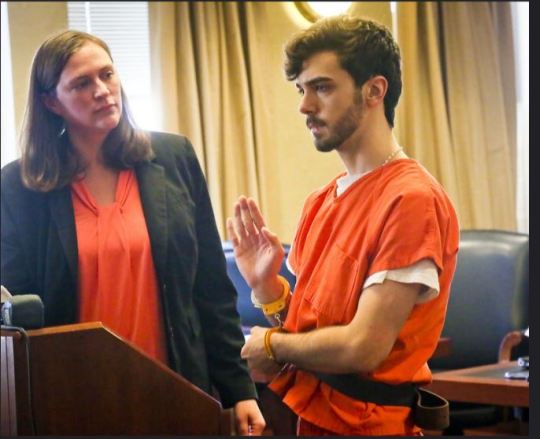
Many prisoners find having to wear such a leather belt, to which the handcuffs are attached by inserting them through the D-ring, and in which case the handcuffs after locking also automatically are attached to the belt too, more humiliating than a belly-chain with handcuffs on it. It feels a bit like being a dog on a leash. The belt indeed can offer a good grip for the guard...

Moreover, a leather belt around the waist is traditionally a symbol of male pride and self-confidence, hence the striking buckles in cowboy culture. There, such a belt embodies male freedom. And that male symbol of freedom is turned into its opposite here: by attaching his handcuffs, to a prisoner it becomes the symbol of his loss of freedom, of his powerlessness.
The photo ends just above the prisoner's knees. Although his feet are not raised, it is almost certain that he is, as its called, 'fully restrained', meaning that in addition to the belt and handcuffs, he is also wearing foot cuffs. That is the standard combination, especially for prisoners on transport. Naturally, these were also applied to the video clip just now. There is little chance that they were omitted in this case. Also he will thus have looked like this outside on the street.
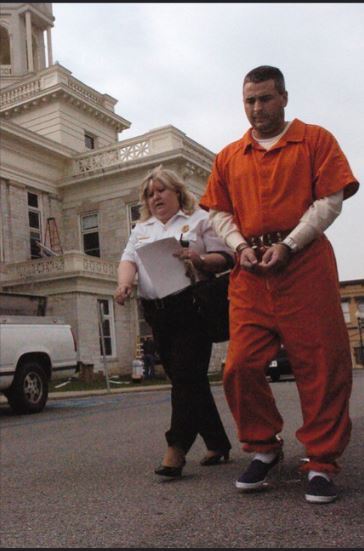
#American Prison#prisonexperience#prison#jail#prisoner#prison uniform#shackles#chains#handcuffs#restrained#full restraints#prison jumpsuit#perp walk#inmate#handcuffed inmate#prisoner transport#American jail#orange prison jumpsuit
131 notes
·
View notes
Text
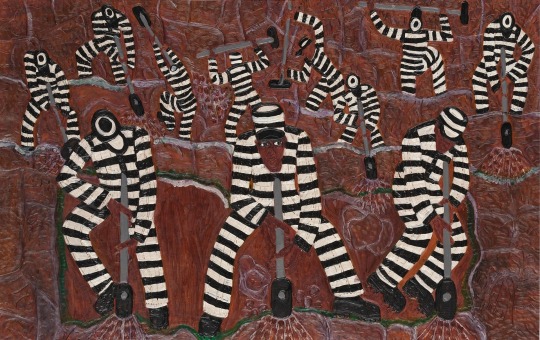
Winfred Rembert (American, 1945-2021), Untitled (Eleven on the Chain Gang), 2011. Dye on carved and tooled leather, 20 7/8 x 33 ½ in.
171 notes
·
View notes
Text
""That's right, pal," says Number Seven. "And take it in these shops. If they'd even teach a guy a trade - make him learn a trade you wouldn't mind. Then a guy would have something to fall back on if he felt like hitting the straight and narrow. But what do they do? They put you to work making automobile plates, or something that's only done in prisons; stuff you couldn't get a job at outside if you wanted to; and the machinery is all twenty years out of date; and the instructors don't know anything about up-to-date methods; and the materials you get to work with are so lousy that you can't learn to do decent work even if you want to. Here I am. I've been working in the shoeshop for five years. What good will that do me? In the first place, the work I'm doing is done by women and children outside; it don't pay any- thing; and if I tried to get away with the lousy kind of work I've been taught to do, I wouldn't last two hours in an outside shop. The print shop is the only shop in here where a guy could learn a decent trade; but Christ, there's only room for forty guys in that shop, and you have to be a high-school graduate to get in there. That don't do the rest of us any good. There's a thousand men here, and only room for forty or so over in the print shop. And not only that, but So-and-So was always threatening to close the print shop because it didn't show enough profits. That's all they think about here. They damn about us learning a trade; all they is having the industries show a profit!"
"And take a guy when he gets out of here," says Number Ten. "Times are lousy outside. Even guys who know their trades, guys that can get swell references, can't get a job nowadays. And if they can't get work, how in the name of Christ are we going to get it even if we want it? And the jobs you can get don't pay anything - not enough to live on. A guy might better be in here than out there starving to death. How the hell is a guy going to live on twenty-five or thirty bucks a week, especially if he's married?"
- Victor F. Nelson, Prison Days and Nights. Second edition. With an introduction by Abraham Myerson, M.D. Garden City: Garden City Publishing Co., 1936. p. 213-214.
#words from the inside#prisoner autobiography#prison industries#released from prison#prison labor#failure of rehabilitation#american prison system#prison routine#prison days and nights#victor nelson#history of crime and punishment#convict labour#reading 2024
81 notes
·
View notes
Text
Imagine this being the same site that used to go to war for people insisting reverse racism or sexism was a thing and how it's natural for the oppressed to hate their oppressors, now loudly has people saying it's violent for women to be weary of men and doing all but calling women hysterical and then those same people loudly clanging their begging bowl and asking for others to extend the type of understanding they do not extend to women but will wax on about community community community! Misogyny isn't oppression to you people. The only oppression with no oppressors and the target of that oppression just needs to suck it up but please please please donate as it's so dangerous for them not to have shelter because they would be a target, which has nothing in common with what women say or worry about.
Extend understanding to people that don't extend it to me ??? Not with my woman ass money
Starve!
#blah#wow you dont feel sorry for ppl like me cool. favour returned#let's work on that empathy before you fix ur face to talk about community#its wild when Americans do this because arent women being thrown into prison for miscarriage???#doesn't thr US have a femicide problem?
65 notes
·
View notes
Note
More Possessive!Camilla Montes?
Camila jumps on Y/N’s back…
Camila: listen up! This one’s mine! All mine!!!
She holds up a fork to another nearby girl…
Camila: stay away! This one’s mine.
Y/N: baby, they all know. And you’re all mine too.
Camila blushes…

#american carnage#camila montes x reader#camila montes imagine#camila montes#jenna ortega imagine#jenna ortega x reader#jenna ortega#possessive girlfriend#prisoners of love
366 notes
·
View notes
Text



McNeil Island, WA.
Permanently closed to the public, used to be a prison that housed inmates, including Manson. Now is largely abandoned but I’m pretty sure a few inmates still remain, as well as lots of patrol guards.
#photos#not my photo#it couldn’t be mine lmao#pnw photography#photography#beautiful photos#abandoned places#abandoned#abandoned house#abandoned prison#regional gothic#small town gothic#appalachain gothic#midwest gothic#suburban gothic#rural gothic#western gothic#gothic americana#american gothic#gothic#appalachian gothic#midwestern gothic#southern gothic#pnw#briscoe park
137 notes
·
View notes
Text
Celebrating Black Queer Icons:
Miss Major Griffin-Gracy

Born on October 25, 1940, Major is a trans women well known as a leader in the broader trans community and an activist, with a particular focus on black and incarcerated trans women. Major grew up in Chicago's South Side and participated in the local drag scene, during her youth. Major described the experiences as glamorous, like going to the Oscars. While she did not have the contemporary language for it, Major has been out as a trans women since the late 1950s. This made her a target of criticism, mistreatment, and violence, even among her queer peers. Majors transition, especially getting her hands on hormones, was largely a black market affair. Given the lack of employment opportunities for black trans women at the time, she largely survived through sex work and other criminalized activities. At some point Major moved to New York City and established herself amongst the cities queer community, despite the prejudice against trans women. She participated in the 1969 Stonewall Uprising. Later, after getting convicted on a burglary charge, Major was imprisoned with men at Clinton Correctional Facility in Dannemora, NY. There she met Frank "Big Black" Smith, a participant in the 1971 Attica Uprising at Attica Correctional Facility. He treated Major, and her identity as a woman, with respect and the two built a friendship. Smith also taught Major a good bit about advocating for herself and other trans women being mistreated by the US Justice System. Major was released from Dannemora in 1974. Major moved to San Diego in 1978 and almost immediately began working on community efforts and participating in grassroots movements. Starting by working at a food bank, she would go on to provide services directly to incarcerated, addicted, and homeless trans women, and would provide additional services after the AIDS epidemic started. In the 1990s Major moved to the San Fransisco Bay Area, where she continued her work, alongside organizations like the Tenderloin AIDS Resource Center. In 2003 Major became the Director of the Transgender Gender Variant Intersex Justice Project, shortly after its founding by attorney and community organizer Alexander L Lee, a trans man. The group works to end human rights abuses in the California Prison System, with a focus on trans, intersex, and gender variant POC. The position has since been passed on to Janetta Johnson, a previously incarcerated trans woman who mentored under Major. She is the focus of the 2015, award winning, documentary Major!. Major has five sons, two biological and three runaways she adopted, after meeting them in a California park. Her oldest son, Christopher was born in 1978, and her youngest, Asiah (rhymes with messiah) in 2021. At 82 years old Miss Major Griffin-Gracy continues to be an active member of her community and an advocate for our rights as trans people.
Haven't settled on which yet, but Willmer "Little Ax" Broadnax or Victor J Mukasa will be next!
#celebrating black queer icons#black history#black history month#black history is queer history#black history is american history#abolish the police#abolish prisons#decriminalize sex work#miss major griffin-gracy#major!#really disappointing to find out she doesnt show up in Popular Tags#stonewall inn#stonewall riots#stonewall uprising#transgender gender variant intersex justice project
339 notes
·
View notes
Text
god american vandal is so good. when peter and sam have to look into each other as suspects and peter actually presents a compelling case about sam's potential crush on gabi but then it like. changes genre as sam gets frustrated with peter for making him look bad and you get this like shocking look at the real consequences of peter's investigation. the moments of like. oh these are real people and his meddling affects the real people in his life and his friendships are falling apart in his search for the truth. fuck I love you american vandal.
#what if this silly mockumentary about graffiti dicks actually made a meaningful commentary#about journalism and the prison industrial system and american school systems#american vandal
37 notes
·
View notes
Text





one day when I am 3% less worried about being cringe I will post my half baked justified fic where they stay together through college/prison and become surprising well adjusted despite you know being Who They Are and also maybe or maybe not committing at least 1 homicide together. Or something g to that effect.
#justified#raylan givens#boyd crowder#these are SO old. like. a year old. but I’m posting them :)#and that’s ok :)#no sorry some of these are even older. my god I’ve been justified pilled for too long. devastated#i just enjoy the idea of raylan being a college super senior doing like work study and taking an American lit elective and being generally#unassuming only to casually drop one day that oh yeah he can’t make it to that class meeting bc he’s gotta go visit his boyfriend in prison#I also like the idea of said boyfriend moving in to Raylan’s off campus house after his realease and his 3 roommates being like hey raylan#uh just curious but why is your excon gay bf reading my ochem textbook also is he selling weed out of our apartment be honest
149 notes
·
View notes
Text






A rare Napoleonic model guillotine made by a French prisoner-of-war who was captured by the British at the battle of Trafalgar.
The creator had a specialty in making miniature guillotines and made this one for a British soldier who had a particular morbid fascination with the reign of terror, or la Terreur. (Bonhams)
#folk art#prison art#guillotine#miniature#toy guillotine#Clive Lloyd The Arts and Crafts of Napoleonic and American Prisoners of War 1756-1816 ACC Woodbridge 2007.#frev#french revolution#first french empire#French empire#first french republic#19th century#napoleonic era#napoleonic#art#arts and crafts#prisoner#soldiers#pow#history#artifact#historical artifacts#artifacts#1800s#early 1800s#early 19th century#french#France#funny#France memes
167 notes
·
View notes
Photo
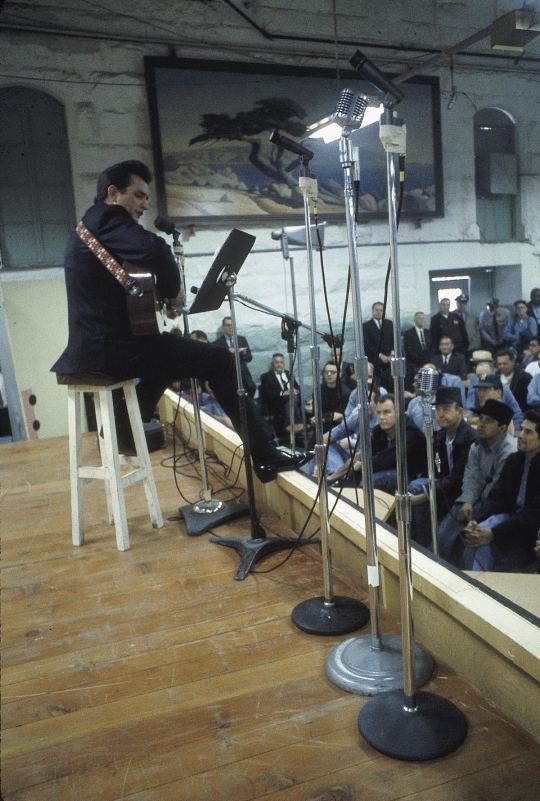
I sat with my pen in my hand, trying to think up the worst reason a person could have for killing another person, and that’s what came to mind.
- Johnny Cash
This is how Cash explained how he came up with the line ‘But I shot a man in Reno, just to watch him die’ in his iconic song ‘Fulsom Prison Blues’.
In 1953, Johnny Cash recorded ‘Folsom Prison Blues’ and two years later included it on his album Johnny Cash and his Hot and Blue Guitar! Cash was inspired to write the song after seeing the 1951 movie Inside the Walls of Folsom Prison while serving in West Germany with the United States Air Force at Landsberg in Bavaria. The location, incidentally, of another famous gaol and where Adolf Hitler wrote Mein Kampf when he was incarcerated after the Munich Beer Hall Putsch in 1924. After the war it was re-named War Criminal Prison No. 1 and kept war criminals convicted at the Nuremberg trials.
Folsom Prison Blues cleverly combined two folk idioms - the train song and the prison song. For decades Cash nearly always opened his gigs with Folsom Prison Blues after greeting the audience with the same introduction each time: “Hello, I’m Johnny Cash,”. On 13th January 1968, Johnny Cash and June Carter, the Statler Brothers, the Tennessee Three, with Carl Perkins on guitar, recorded a live version of the song before the prisoners of Folsom State Prison, Folsom, California. The performances - one in the morning, another in the afternoon - can be heard on the album Johnny Cash At Folsom Prison.
358 notes
·
View notes